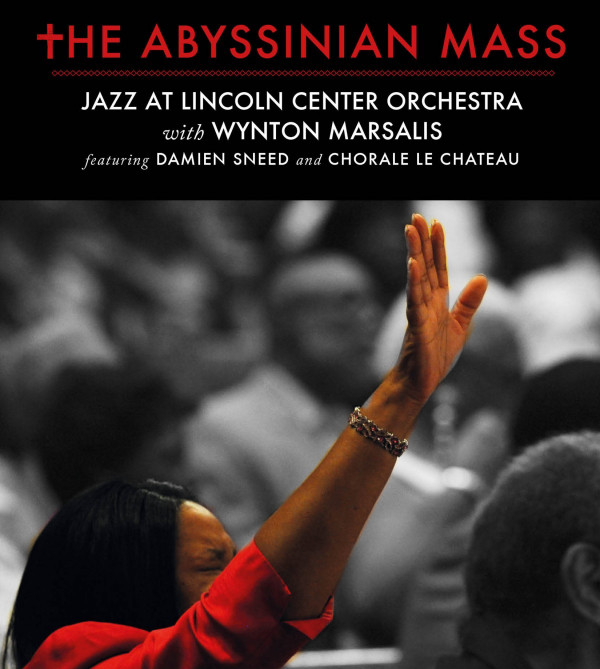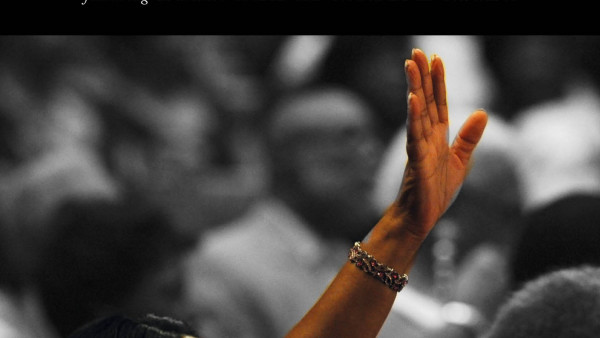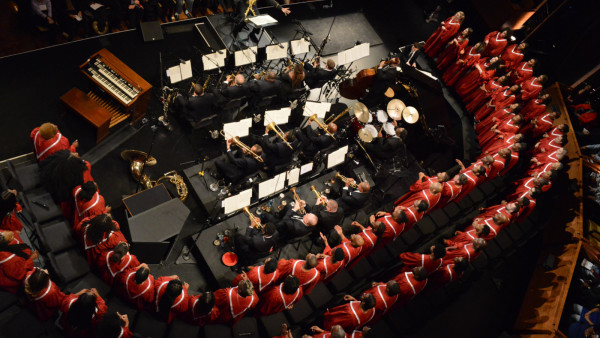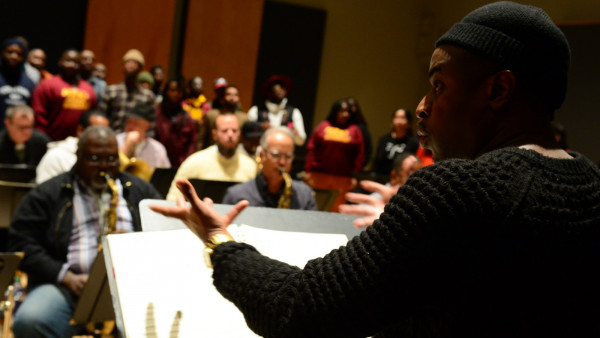Sacred jazz: Reflections on a rare performance of Marsalis’ ‘Abyssinian Mass’
Since its beginnings, jazz has been draped in the image of sin.
Because the music emerged, in part, in the bordellos of New Orleans’ Storyville vice district at the turn of the previous century, the world has viewed jazz as embodying the illicit.
Never mind that European classical music, all-American marching bands and age-old church hymns also helped create a music that tells this country’s ethnically complex story. Most of this has been overshadowed by jazz’s association with the forbidden.
You can see it throughout our popular culture. When Mark Hamill wanders into a barely lit bar populated by strange and menacing aliens in “Star Wars,” what kind of music is the house band playing? Old-fashioned gutbucket jazz. When Jimmy Stewart imagines the decadent Pottersville in “It’s a Wonderful Life,” what sounds accompany his living nightmare? The wailings of raucous jazz musicians.
From the dissipated characters in Weill and Brecht’s “The Threepenny Opera” to the hedonistic excesses of Rodgers and Hart’s “Pal Joey” to the soundtracks of uncounted film noir classics, jazz has been used to signal sensuality and transgression.
But the music has an equally vital – if much less celebrated – sacred side, which was robustly expressed at Jazz at Lincoln Center’s Rose Theater on Nov. 21. In a rare revival of Wynton Marsalis’ “The Abyssinian Mass” – commissioned by Harlem’s Abyssinian Baptist Church in 2009 – listeners took a journey from doubt to belief, from sin to redemption, via jazz composition and improvisation.
One hastens to note that Marsalis is hardly the first jazz composer to explore spiritual concerns. Duke Ellington’s Sacred Concerts, John Coltrane’s “A Love Supreme,” Mary Lou Williams’ “Mass,” Dave Brubeck’s “The Gates of Justice” and other major
works have shown jazz contemplating the divine.
Even Marsalis himself already pursued this path in one of his most compelling works, “In This House, on This Morning” (1994), in which his septet traced the contours of a gospel church service via mostly instrumental jazz performance.
“The Abyssinian Mass” builds expansively on that precedent, and others, in that a gospel choir – Chorale Le Chateau – drives the action forward through fervently sung text, accompanied by the Jazz at Lincoln Center Orchestra. In effect, “The Abyssinian Mass” conveys the same message of hope and faith as “In This House, on This Morning,” but more explicitly (thanks to the words) and more ambitiously (due to its larger vocal-instrumental forces).
The evening-length piece, conducted by Damien Sneed, opened with a “Devotional” call and response between singers and instrumentalists, members of the gospel choir chanting “I didn’t hear nobody prayin’, I didn’t hear nobody sayin’, I didn’t hear nobody calling on the Lord.” Trumpeters Marcus Printup and Kenny Rampton answered these pleas with soaring phrases of their own in a “Call to Worship,” setting the stage for “The Lord’s Prayer.” To hear its indelible words sung a cappella by the choir, en masse, followed by some of Marsalis’ most virtuosic brass-section writing, was to perceive this work’s ambitious scope.
From this point forward, “The Abyssinian Mass” offered a headlong march to glory – musical, spiritual and otherwise. Prayer and meditation, scriptural quotation and colloquial recitation proclaimed the joys of faith in blues-swing syntax.
At a key turning point, Rev. Dr. Calvin O. Butts III delivered an impassioned sermon, his words carrying a music and rhythmic sway of their own.
“We’re going to have church tonight!” Rev. Butts proclaimed at the podium, his very presence personifying the links between spirituality and jazz. For anyone who still questioned this bond, Rev. Butts told his de facto congregants in the Rose Theater that “The Abyssinian Mass” is “divine music. It’s spiritual music.” And that on this night, “This house is God’s house!”
But even as words sung and spoken dominated this work, the orchestra had its say, too, in three movements Marsalis wrote for the “Offertory.” Its most memorable moments included trumpeter Printup’s solemn phrases in “The Father,” trumpeter Marsalis’ stratospheric flights in “The Son,” and drummer Herlin Riley’s exhortations in “The Holy Ghost” (a less demonic piece of music than its counterpart from “In This House”).
In a direct tip of the hat to Ellington’s Sacred Concerts, Marsalis’ opus also featured a sequence for tap dancer Jared Grimes, his juxtaposition of hard accents and fleet footwork reflecting this score’s expressive range.
As “The Abyssinian Mass” approached its finale, you felt as if you’d been on an epic journey, its aspirations communicated via trombonist Chris Crenshaw’s sung chants, the choir’s incantations, and the soft and otherworldly whistling of all the musicians involved.
The work’s last moments – restrained rather than effusive, calm rather than climactic – suggested a kind of resolution or arrival. The final sounds we heard were of human voices alone intoning, “Amen, amen, amen.”
In the end, “The Abyssinian Mass” can be considered a counterpart to Marsalis’ “In This House” – a more extroverted, more accessible way of articulating an unyielding faith. But “Abyssinian” also stands as another significant reminder – like those of Ellington and others – that jazz and the church remain inseparable, even if many audiences don’t realize it.
There’s no conflict between lusty music-making and sacred aspirations, between blue-note dissonance and Handelian choral writing, between folkloric gospel singing and ultra-sophisticated jazz improvisation.
On the contrary, one enriches the other, as “The Abyssinian Mass” attests.
by Howard Reich
Source: Chicago Tribune




